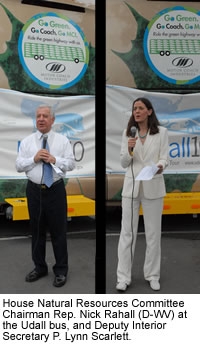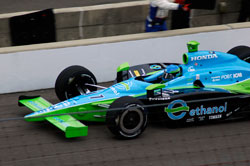Officials with the National Corn Growers Association say the U.S. is on target to reach a 15-billion-gallon-a-year production goal… much earlier than the original 2015 goal.
 In fact, NCGA President Ken McCauley tells the Kansas City Star that goal could be reached as early as 2011 or 2012:
In fact, NCGA President Ken McCauley tells the Kansas City Star that goal could be reached as early as 2011 or 2012:
That reflects the growing confidence within the ethanol industry about its prospects in an era of expensive gasoline. But the association’s view is especially interesting in that additional production of corn, currently the main feedstock for ethanol, is crucial in meeting the rosier projections for ethanol.
McCauley noted the country’s corn farmers were ramping up production.
About 10.5 billion bushels of corn were harvested last year and an estimated 12.5 billon would be produced this year. Improved yields and more acres planted with corn should eventually increase production to 15 billion bushels, with about a third of that used for ethanol. A bushel of corn currently produces roughly 2.8 gallons of ethanol.
“We look at this as a real opportunity for agriculture,” he said.
The article goes on to say that the Renewable Fuels Association pegs current ethanol production at 6.2 billion gallons a year and expects that to double by early 2009.


 NearBio, the innovator of technology that sends to your computer, cell phone, or mobile device info on where the nearest alternative fuel station is, has established a new web site:
NearBio, the innovator of technology that sends to your computer, cell phone, or mobile device info on where the nearest alternative fuel station is, has established a new web site: 
 According to
According to  “We are pleased to see that the Udall Foundation and the federal agencies and equipment manufacturers who are sponsoring the tour recognize biodiesel’s valuable contribution to the environment,” said NBB Chief Executive Officer Joe Jobe. “It is only fitting that the bus tour will feature many National Parks since the Park Service’s fleets were among the first in the nation to use biodiesel. Today, hundreds of fleets, including government, commercial and school buses, use biodiesel to benefit America’s environment, energy security and economy.”
“We are pleased to see that the Udall Foundation and the federal agencies and equipment manufacturers who are sponsoring the tour recognize biodiesel’s valuable contribution to the environment,” said NBB Chief Executive Officer Joe Jobe. “It is only fitting that the bus tour will feature many National Parks since the Park Service’s fleets were among the first in the nation to use biodiesel. Today, hundreds of fleets, including government, commercial and school buses, use biodiesel to benefit America’s environment, energy security and economy.”
 “Making these funds available represents this Administration’s ongoing commitment to promoting clean energy technologies to help diversify our nation’s energy mix in an environmentally sensitive way,” Energy Secretary Samuel Bodman said. “I am hopeful that these projects will play a critical role in furthering our knowledge of how we can cost effectively produce more homegrown, bio-based products to help reduce our reliance on imported sources of energy.”
“Making these funds available represents this Administration’s ongoing commitment to promoting clean energy technologies to help diversify our nation’s energy mix in an environmentally sensitive way,” Energy Secretary Samuel Bodman said. “I am hopeful that these projects will play a critical role in furthering our knowledge of how we can cost effectively produce more homegrown, bio-based products to help reduce our reliance on imported sources of energy.” Congress’ financial watchdog, the Government Accountability Office, says the U.S. Department of Energy lacks a plan for how to match up increased biofuels production with infrastructure and vehicles to use the green fuels.
Congress’ financial watchdog, the Government Accountability Office, says the U.S. Department of Energy lacks a plan for how to match up increased biofuels production with infrastructure and vehicles to use the green fuels. I-CARES will foster institutional, regional and international research on the development and production of biofuels from plant and microbial systems and the exploration of sustainable alternative energy and environmental systems and practices. Funding for the project will include a $55 million investment from Washington University.
I-CARES will foster institutional, regional and international research on the development and production of biofuels from plant and microbial systems and the exploration of sustainable alternative energy and environmental systems and practices. Funding for the project will include a $55 million investment from Washington University. While I was attending last week’s
While I was attending last week’s  Number 17 Team Ethanol car driver Jeff Simmons was a lap leader for five laps at the
Number 17 Team Ethanol car driver Jeff Simmons was a lap leader for five laps at the